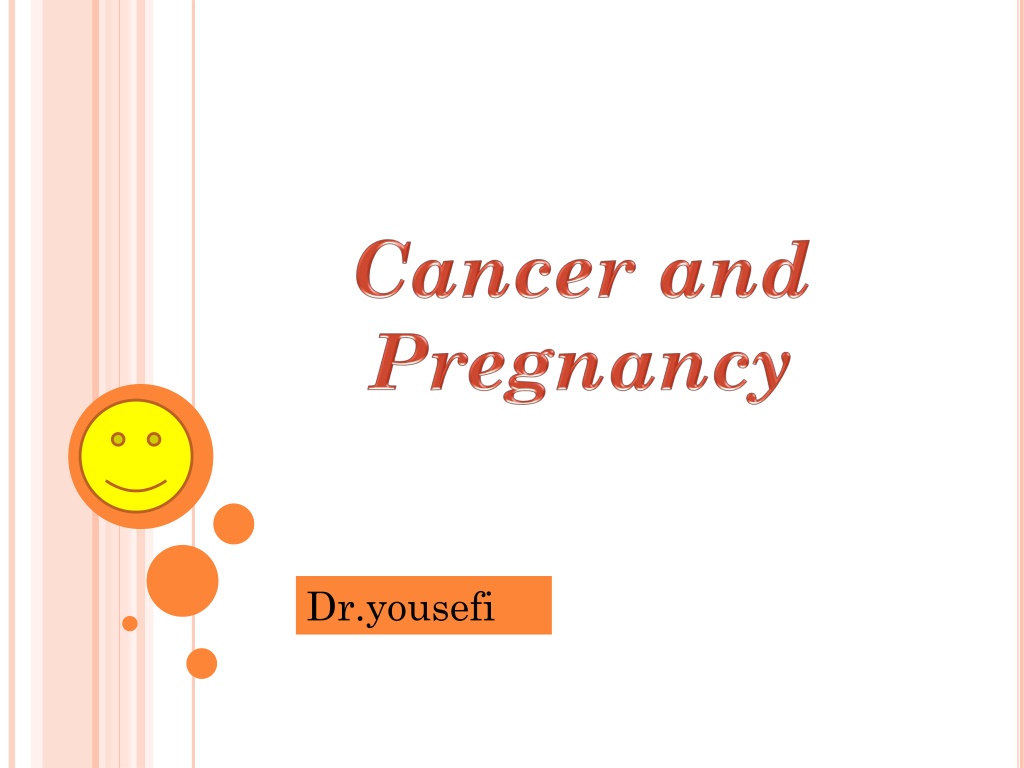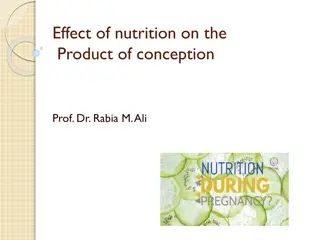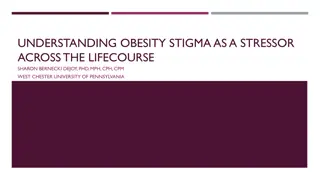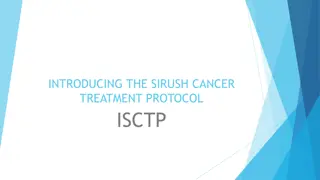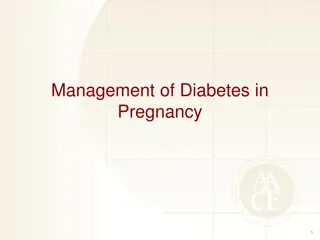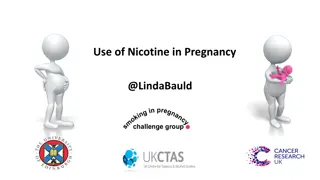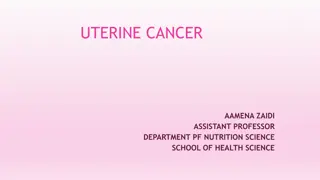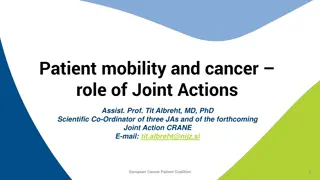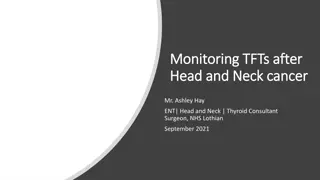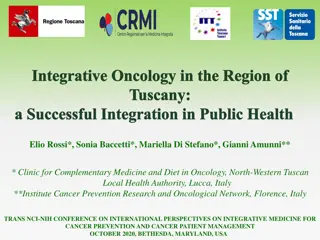Cancer Treatment during Pregnancy: Considerations and Risks
Cancer treatment during pregnancy requires individualized consideration of cancer type, stage, pregnancy continuation desire, and risks of modifying or delaying treatment. Commonly diagnosed cancers in pregnancy include breast, cervix, melanoma, and Hodgkin's disease. Radiotherapy and chemotherapy carry potential risks to the fetus, with adverse effects including microcephaly and mental retardation. Timing of fetal development is crucial, and therapeutic radiation exposure can impact fetal health at any gestational age.
Download Presentation

Please find below an Image/Link to download the presentation.
The content on the website is provided AS IS for your information and personal use only. It may not be sold, licensed, or shared on other websites without obtaining consent from the author. Download presentation by click this link. If you encounter any issues during the download, it is possible that the publisher has removed the file from their server.
E N D
Presentation Transcript
Radiotherapy in pregnancy Chemotherapy in pregnancy Surgery in pregnancy Genital cancer I n pregnancy Others cancer in pregnancy
Trend to defer childbearing into the fourth decade of life when the incidence of some of the more common malignant neoplasms begins to rise
she should not be penalized because she is pregnant. That said, treatment must be individualized and include consideration of the type and stage of cancer, her desire to continue the pregnancy, and risks of modifying or delaying treatment
The most commonly diagnosed cancers in pregnancy are: cancer of the breast and cervix, melanoma, and Hodgkin's disease
Radiotherapy in pregnancy
Preimplantation period produce all or non effect The most sensitive period for the fetus is 18-38 days (organ system period ) visceral or somatic damage Fetal development after 40 days produces external malformations
therapeutic radiation often results in significant fetal exposure. The amount depends on the dose, tumor location, and field size. Although the most susceptible period is during organogenesis, there is no gestational age considered safe for therapeutic radiation exposure.
Adverse effects include: cell death, carcinogenesis, and genetic effects on future generations. Characteristic adverse fetal effects are microcephaly and mental retardation.
Radiation induced carcinogenesis Pregnancy represents a time of increase sensitivity of breast tissue to the carcinogenic effects of radiation Exposure to ionizing may have genetic consequence Recessive mutations may not apparent for several generations No apparent threshold dose for genetic damage Pregnancy should be delayed 12-14 months after significant exposure
Gonadal irradiation involve possible genetic damage : Gen mutation or chromosome breakage Dose >50cGy produce significant mental retardation 3-5cGy results benign and malignant tumors in the child after birth Low dose exposure <100c Gy seem acceptable only in third trimester
In some cases, such as head and neck cancers, radiotherapy to supra diaphragmatic areas can be given relatively safely with abdominal shielding. In others, such as breast cancer, significant scatter doses can accrue to the fetus.
Irradiation of even supra diaphragmatic structure will deliver fetal dose1.2-7.1 cGy
Diagnostic radiology: Chest x-ray 300 mcGy per plate Barium enema 6cGy Sentinel node identification avoidance dose >0.05-0.1 Iodine -131 termination of pregnancy
Chemotherapy in pregnancy
Three stages o f embryonic development : Too weeks of life ; resistant to teratogens Third to eighth weeks maximal susceptibility to teratogen (brain and gonadal tissue are exception because continue to differentiate beyond the second period) Major congenital anomalies 9-38weeks or fetal period (organ developments) functional defects and minor anomalies
Second and third trimester exposure is associated primarily with: intrauterine growth restriction and low birth weight as well as potentially preterm deliveries and neonatal myelosuppression
Chemotherapy during the first trimester has been shown to increase the risk of spontaneous abortions, major malformations, and fetal demise and thus should be avoided unless termination of pregnancy is planned.
Small intermittent doses of a teratogen may interfere with cellular metabolism and cause more serious malformation than might be expected
patients with documented distant metastases may be able to initiate systemic chemotherapy during pregnancy, thus providing the mother with the appropriate therapy while allowing more time for fetal growth and maturation
Classes of anti neoplastic agents : Antimetabolites: methoteraxate 5-fu (aminopterin syndrome) therapeutic abortion Alkylating agents: cyclophosfomide chloroambocil anti tumor antibiotic :adrimycin actinomycin bleomycin safe in second and third trimester Alkaloids taxanes Platinum analog (second and third trimester is safes)
physiologic changes that occur with pregnancy, including: Increases in blood volume and renal as well as hepatic clearance might be expected to reduce active concentrations in normal pregnancy diminished gastric motility may impact the absorption of orally administered drugs. Plasma albumin decreases, increasing the amount of unbound active drug; however, this effect is counterbalanced by high levels of estrogen which increase other plasma proteins The "third space" of the amniotic sac is a concern for drugs such as methotrexate, but this drug is avoided during pregnancy
Safe use of G-CSF (and recombinant erythropoietin) in human pregnancy has been reported
Ideally, there should be three weeks between completion of chemotherapy and delivery so the bone marrow can recover, and to allow the placenta to metabolize and eliminate cytotoxic drugs from the fetus . Since the potential for spontaneous labor increases towards the end of pregnancy, it is prudent to avoid administering chemotherapy in the late third trimester
Placental pathology is mandatory in all cases following delivery
Surgery in pregnancy
Surgical removal of tumors is often possible with minimal risk of disrupting the pregnancy. Surgery during the early second trimester is ideal, but surgery at any gestational age is reasonable if it will maximize the chance of cure and long-term surviva
in the late second and early third trimester, a treatment delay of three weeks may convey significant gains in fetal prognosis, while the delay is unlikely to alter the maternal outcome
In a modern neonatal intensive care unit, the neonatal survival rate at 28 weeks gestation following antenatal corticosteroid administration is well above 90%. In addition, long-term neurologic outcome is near normal in over 90% of survivors
The method of delivery should be determined by obstetrical indications. The presence of a malignancy is not an indication for cesarean delivery
Documented fetal heart tone by doppler pre and post operative use of external tocodynamometer post operative prophylactic indomethacine at a rectal dose of 25 50 mg prior 30 weeks pre and post operative Use of extremity sequential compression device intra and post operative
Anesthesia: The vast majority of analgesics and anesthetics are category C drug Small diameter endotracheal tubes for facilitate intubation in later of pregnancy ( when airway edema increase) Increase risk aspiration (lower esophageal sphincter pressure) Narcotic benzodiazepines muscle relaxants to be safe
Cervical Intraepithelial Neoplasia and Invasive Carcinoma of the Cervix
The ability to detect early neoplasia by physical examination is limited by pregnancy-associated cervical changes, such as cervical decidualization, ectropion, and stromal edema; in late pregnancy, detection is further impeded by cervical ripening.
Colposcopic evaluation of the cervix in pregnancy can be challenging; it should be done by colposcopists experienced the increased vascularity of the gestational cervix exaggerates the way immature metaplastic epithelium reacts to acetic acid, which may mimic a dysplastic lesion Conversely, early neoplastic cervical lesions in pregnancy may be mistaken for the normal eversion of the squamocolumnar junction or benign cervical decidualization.
If colposcopy in early pregnancy is unsatisfactory, repeating the procedure in 6 to 12 weeks may result in a satisfactory examination because the transformation zone may have "migrated" to the ectocervix, thus allowing a satisfactory examination by 20 weeks of gestation
Multiple biopsies need not all be taken on one occasion but rather may be obtained over time. Biopsy sites may actively bleed because of hyperemia, but this can be stopped with Monsel solution, silver nitrate, vaginal packing, or suture.
Currently the recommendations for addressing abnormal Pap tests during pregnancy favor a conservative approach in the absence of frankly malignant cells.
In women with an ASC-US Pap smear but HPV negative test, the recommendation is also to repeat both at the 6-week postpartum visit
The current guidelines recommend that for women older than 21 years of age, ASC-US and a positive HPV test may be managed by colposcopy at the time of diagnosis, or colposcopy may be deferred until the postpartum evaluation
ASCCP guidelines state that colposcopy is preferred for the nonadolescent pregnant woman with LSIL, but deferring this procedure until at least 6 weeks postpartum is an option provided there is no cytologic or macroscopic evidence of a more invasive process
For pregnant women with CIN 1, the recommended management is reevaluation postpartum. For those with CIN 2 or 3 in the absence of invasive disease or advanced pregnancy, additional colposcopic and cytological examinations are acceptable at intervals no more frequent than every 12 weeks.
HSILit is recommended that colposcopic examination be performed by clinicians with experience in pregnancy-induced cytological changes. Lesions suspicious for high-grade disease or cancer should be biopsied. In the event of unsatisfactory colposcopy, repeat examination should be performed in 12 weeks. After delivery, repeat cytology or colposcopy should generally be delayed for at least 6 weeks to allow reparative healing
Atypical glandular cells (AGC) on a Pap smear should be thoroughly evaluated at any time during pregnancy and the pregnant woman with atypical glandular cells or adenocarcinoma in situ on a Pap smear should undergo colposcopically directed biopsies and if indicated, cervical conization or loop electrosurgical excision procedure
LEEP should primarily be reserved for patients in the early stages of pregnancy in whom the presence of invasive disease is strongly suspected
